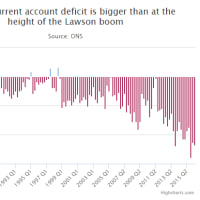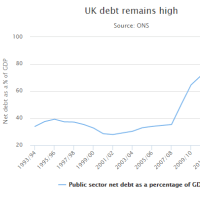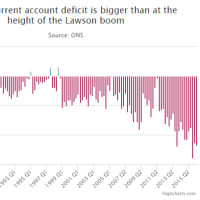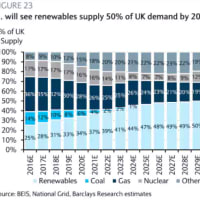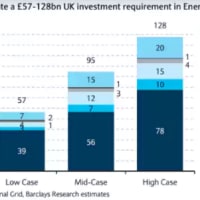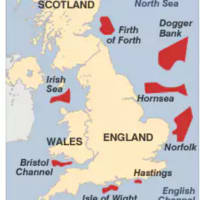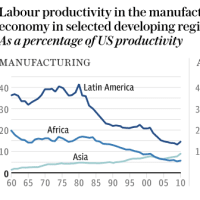つづき
"Historically, over 50 per cent of struggling homeowners would refinance or remortgage themselves out of trouble, but this option is less readily available today."
「歴史的に見て、やりくりに苦しむ住宅所有者の50%以上は、借り換えをしたり、モーゲージを借り替えたりして難を逃れてきた。しかし今日、この選択肢は容易に手配出来ない」。
Higher mortgage rates and reluctant lenders mean that stretched households no longer have an easy pool of equity available from which to bail themselves out of trouble.
モーゲージ金利の上昇、そして貸付機関の貸し渋り。
これは負担が大きくなった家計が、トラブルから抜け出すために安易に資金を調達出来なくなったことを意味している。
The fear now is that the situation has reversed and people are using their credit cards to pay their mortgages, now that repayments are soaring given that 1.4m people come off attractive fixed-rate deals this year.
現在懸念されるのは、この状況が逆転し、皆がモーゲージの返済を行うためにクレジットカードを使うようになるのではないか、ということだ。
今年は140万人が、魅力的な固定金利型モーゲージ契約満期を向かえることを考えてみれば、現在モーゲージ返済額は急騰している。
Peter Crook, chief executive of doorstep lender Provident Financial, has heard such stories and described them as a "big red warning sign".
訪問貸付機関プロヴィデント・フィナンシャルのピーター・クルック代表は、このような話を耳にしており、これを「巨大で真っ赤な危険警報ランプ」と評した。
Certainly, the statistics suggest the public retains an unhealthy appetite for debt. Bank of England figures show that growth in credit card lending has accelerated since the crisis struck. Credit card debt rose 1.3 per cent in June last year compared with June 2006. Annual growth was 7.1 per cent this June and now stands at £55bn.
勿論、データは皆が不健全な借金意欲を自制している、と示している。
信用危機が始まって以来、クレジットカードによる借入額の増加は加速した、とBoEのデータは示している。
昨年6月、クレジットカードによる借入は、2006年6月と比べて1.3%増加した。
今年6月の年率成長率は7.1%であり、現在の残高は£550億となっている。
Apacs, the payments network, suggests this could hit £160bn if those 31m credit cards are taken to their limit. Overall, the public is still taking roughly £1bn of new unsecured debt every month, numbers from the Bank show. Including mortgages, Britons have £1,440bn of personal debt.
支払ネットワークのApacsは、3,100万枚のクレジットカードが上限金額まで使われれば、この金額は£1,600億に達するだろうとしている。
全体的に見ると、利用者は毎月約£10億の新規無担保ローンを借り入れている、とBoEのデータは示している。
モーゲージを含めれば、イギリス人は総額£1.44兆もの個人債務を抱えているのだ。
The numbers are staggering and unsettling. For banks, as the table shows, the big figures are in mortgages but the big risks lie in the consumer credit portfolios. In the recession of the early 1990s, impairment provisions on the banks' mortgage books increased to 0.4 percentage points. By comparison, the impairment on the unsecured loan book was 3.69 percentage points (the corollary of the higher risk, of course, is that it is a more expensive product).
この数値は仰天するものであり、不安をもよおすものだ。
下の表が示すように、銀行にとって金額が大きいのはモーゲージだが、高リスクは消費者金融の方だ。
1990年代初頭の不況の際、銀行のモーゲージ帳簿における減損に対する繰入額は0.4%に増加した。
一方、無担保ローン帳簿は3.69%だ(勿論、よりリスクが高いのだから、当然の結果としてより高額な商品なのだ)。
Credit Suisse reckons the extra provisions from unsecured credit could be higher than mortgage impairments this time. A "sensitivity" study on HBOS' loan book conducted by the investment bank shows the unsecured bad debt charge running up to £3.25bn in a 1990s-style Armageddon scenario compared with a £1.66bn charge against its much bigger mortgage portfolio.
クレディ・スイスは、今回は、無担保ローンの追加繰入額は、モーゲージの減損分よりも高くなるだろうとしている。
同投資銀行によって実施された、HBOSのローン帳簿の「感度」調査は、1990年代型のハルマゲドン・シナリオを辿った場合、無担保ローンの焦げ付きは£32.5億に達するだろう、と示している。
対する、これよりも遥かに大きなモーゲージ・ポートフォリオは、£16.6億である。
The banks' overzealous lending back in 2003 and 2004 may return to haunt them. Bad debts on the unsecured book are already double the 1990s peak. Lloyds TSB, which can be used as a proxy for the industry, broke the numbers down in its results - showing the bad debt charge as a percentage of lending on personal loans at 5.43 per cent and 7.84 per cent on credit cards. In the 1990s, the recession saw impairment levels more than double. Debt specialists say they would not be surprised this time if credit card provisions hit 20 per cent.
2003年と2004年に銀行が行った余りにも過剰な貸付は、彼らを脅かすべく戻ってくるかもしれない。
無担保ローンの不良債権は、既に1990年代のピークの倍に達している。
この業界の代表とすることが出来るロイズTSBは、決算の中で数字を細分化した。
これは不良債権をパーセンテージで示しており、消費者ローンの場合は5.43%、クレジットカード・ローンは7.84%だった。
1990年代、不況で減損レベルは倍増した。
今回クレジットカード繰入額が20%に達しても驚かない、と債務専門家は言っている。

Concerns have already been raised by the recent Bank of England credit conditions survey, which revealed that banks were surprised by the level of bad debts run up on their credit cards in the second quarter of the year. A study out last week from market research group Maritz Research added to the general gloom. A survey of 1,000 homeowners found that "40 per cent already have acute financial problems".
銀行が今年Q2のクレジットカードの焦げ付き水準に驚いた、と明らかにした、BoEが先日行った信用状況調査により、懸念は既に深まっている。
マーケットリサーチ会社マリツ・リサーチが先週公表した調査は、更に陰鬱さを深めた。
1,000世帯を対象とした調査は、「既に40%の世帯が重大な財政問題に見舞われている」と見出した。
HSBC also revealed recently that its 8.2m current account holders typically have 5 per cent less money in their accounts than a year ago, graphically illustrating the rising cost of living. Joe Garner, head of HSBC's personal financial services in the UK, said: "People are really feeling the squeeze. There is definitely some strain there."
また、HSBCは820万件の普通口座の残高が一年前よりも5%減少している、と明らかにしたが、これは生活費の上昇を具体的に見せつけている。
イギリスHSBCのパーソナル・ファイナンス・サービスのジョー・ガーナー部長は「皆圧迫をひしひしと感じている。明らかに負担が生じている」と語った。
So why do the insolvency and bank impairment figures tell a different story? Analysts say this is because banks are rejecting more IVAs and working with customers to solve debt problems. "Banks are opting for debt management plans and have been clamping down on IVAs," said one analyst, who asked not to be named. "It flatters their provisioning policy. They would have had to write down an IVA almost immediately. Debt management plans delay the impairment and the banks are likely to lose less."
では何故、破産や銀行の減損額は、異なった様相を描き出しているのだろうか。
IVA申請の却下件数を増やし、債務問題解決へ向けて、顧客と協力することを増やしているからだ、とアナリストは語る。
「銀行は債務管理計画の方を選択しており、IVAを抑制している」と某アナリスト(匿名希望)は語った。
「これは彼らの繰入方針を、実質よりもよく見せている。本当はほぼ即座にIVAを評価損計上しなければならないのに。債務管理計画は減損を先送りして、銀行の損を減らすだろう」。
Delaying bad news may not seem prudent but, given the £10bn of writedowns against structured credit assets that Britain's banks had to take in the first half, the less bad news the better. The more provisions they have to take, the less cash left to lend out to prospective house-buyers and corporates - prolonging any downturn.
悪いニュースを遅らせることは賢明とは見えないかもしれないが、イギリスの銀行が上半期に受け容れなければならなかった、ストラクチャード・クレジット資産に対する£100億もの評価損を考えてみれば、悪いニュースは少ない方が良いのかもしれない。
銀行が受け容れなければならない減損が増えるほど、家を買おうとしている人々や企業に貸し出せる現金が減るだろう…そして、景気減速を長引かせるだろう。
Royal Bank of Scotland, Barclays, HBOS and Bradford & Bingley have recapitalised with £21bn of funds from shareholders, which will cushion them against some of the increase in provisions and allow them to continue their vital service of lending to people and companies. But the jury is out on just how long this extra capital will last.
RBS、バークレーズ、HBOS、そしてブラッドフォード&ビングレーは、株主から£210億の新規資本を調達した。
これは繰入額増加を一部カバーし、個人や企業に対する重要な貸付サービスを継続する助けになるだろう。
しかしこの追加資本もどれだけもつか、未だわからない。
Some believe the banks' unsecured credit problem after 2003 and 2004, when the bad debt charge hit 6 to 7 per cent, was a warped blessing by encouraging them to rein in lending and improve standards.
一部の人々は、貸倒損失が6-7%に達した2003年と2004年の後、銀行の無担保ローンの問題は、貸付自粛と基準改善を奨励したことによる歪んだ恩恵だ、と考えている。
Banks certainly seem to believe they have got their unsecured debts under control. But, as the credit crisis has shown, such confidence is not always an encouraging sign.
銀行は勿論、自分達は無担保ローンも管理してきた、と考えているようだ。
しかし、信用危機が示したように、このような自信は常に喜ばしい兆しではない。
 | KGBの世界都市ガイド晶文社このアイテムの詳細を見る |










